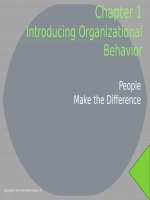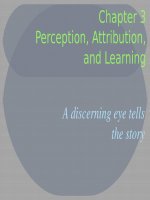Lecture Organizational behavior - Chap 11: Power and politics
Bạn đang xem bản rút gọn của tài liệu. Xem và tải ngay bản đầy đủ của tài liệu tại đây (4.46 MB, 30 trang )
Chapter 11
Communication
Communicating for
relationships and results
Chapter 11 Study
Questions
What Is Communication?
What are Barriers to Effective Communication?
What Is the Nature of Communication in
Organizational Contexts?
What Is the Nature of Communication in
Relational Contexts?
Why is Feedback So Important?
Copyright © 2014 John Wiley & Sons,
11-2
What is communication?
Communication
• A process of sending and receiving
messages with attached meanings.
Copyright © 2014 John Wiley & Sons,
11-3
Figure 11.1 The Communication
Process
Copyright © 2014 John Wiley & Sons,
11-4
What is communication?
Sender
• A person or group trying to communicate with
someone else.
Encoding
• The process of translating an idea or though into a
message consisting of verbal, written, or nonverbal
symbols or some combination of them.
Communication Channels
• The pathways through which messages are
communicated.
Receiver
• Decodes the message into a perceived meaning.
Copyright © 2014 John Wiley & Sons,
11-5
What is communication?
Copyright © 2014 John Wiley & Sons,
11-6
What is communication?
Feedback
• Communicates how one feels about something
that another person has done or said.
Copyright © 2014 John Wiley & Sons,
11-7
What is communication?
Potential barriers to feedback in the workplace
Noise
•
Anything that interferes with the effectiveness of
communication.
Copyright © 2014 John Wiley & Sons,
11-8
What are Barriers to
Effective
Nonverbal communication
Communication?
• Takes place through facial expressions, body
position, eye contact, and other physical
gestures.
Presence - the act of speaking without using
words.
Copyright © 2014 John Wiley & Sons,
11-9
Figure 11.2 Furniture Placement and
Nonverbal Communication in the
Office
Copyright © 2014 John Wiley & Sons,
11-10
What are the barriers to effective
communication?
Interpersonal barriers
• Occur when individuals are not able to
objectively listen to the sender due to things
such as lack of trust, personality clashes, a
bad reputation, or stereotypes/prejudices.
Selective listening – Individuals block out
information or only hear things that match
preconceived notions.
Filter – Convey only parts of the
information (e.g., not to tell the “whole”
truth).
Avoidance – Occurs when individuals ignore
or deny a problem rather than confront it.
Copyright © 2014 John Wiley & Sons,
11-11
What are the barriers to
effective communication?
Physical distractions
• Another barrier that can interfere the
effectiveness of the communication
process.
Copyright © 2014 John Wiley & Sons,
11-12
What are the barriers to
effective communication?
Semantic barriers
• Involves a poor choice or use of words
and mixed messages.
• Use the KISS principle of communication.
“Keep it short and simple.”
Copyright © 2014 John Wiley & Sons,
11-13
What are Barriers to
Effective
Communication?
Cultural Barriers
• Ethnocentrism – the tendency to believe
one’s culture and its values are superior
to those of others.
• Parochialism – assumes that the ways of
your culture are the only ways of doing
things.
Copyright © 2014 John Wiley & Sons,
11-14
What are Barriers to Effective
Communication?
CrossCultural Communication
Low – content cultures - message are expressed
mainly by the spoken and written word.
High – content cultures – words convey only part of
message while the rest of the message must be
inferred from body language and additional
contextual cues.
Copyright © 2014 John Wiley & Sons,
11-15
What are Barriers to
Effective Communication?
Ethnocentrism
• The tendency to believe that one’s culture and
its values are superior to those of others.
• Cross-cultural communication challenges:
Language differences
Use of gestures
Parochialism
The ways of your culture are the only ways of
doing things.
Copyright © 2014 John Wiley & Sons,
11-16
What are Barriers to
Effective Communication?
Lowcontext cultures
• Members are very explicit in using the spoken
and written word.
Highcontext cultures
• Use words to convey only a limited part of the
message.
• The rest must be inferred or interpreted from
the context.
Copyright © 2014 John Wiley & Sons,
11-17
What is the Nature of
Communication in
Organizational Contexts?
Formal channels
• Follow the chain of command established by an
organization’s hierarchy of authority.
Informal channels
• Do not adhere to the organization’s hierarchy of
authority.
Copyright © 2014 John Wiley & Sons,
11-18
What is the Nature of
Communication in
Organizational Contexts?
Grapevine
• A network of friendships and
acquaintances through which rumors and
other unofficial information get passed
from person to person.
Copyright © 2014 John Wiley & Sons,
11-
What is the Nature of
Communication in
Organizational Contexts?
Channel richness
• The capacity of a communication
channel to convey information.
Copyright © 2014 John Wiley & Sons,
11-20
Figure 11.3 Richness of
Communication Channels
Copyright © 2014 John Wiley & Sons,
11-21
What is the Nature of
Communication in Organizational
Contexts?
Communication Flows
• Downward communication Follows the chain of
command from top to bottom.
• Lateral communication The flow of messages at the
same levels across organizations.
• Organizational Silos Unites that are isolated from one
another by strong departmental or divisional lines.
Upward Communication Differences between persons of
Copyright © 2014 John Wiley & Sons,
higher and lower ranks.
11-22
What is the Nature of
Communication in
Organizational Contexts?
Voice and Silence
Voice
•
Involves speaking up to share ideas,
information, suggestions and concerns upward
in organizations. Confronting situations rather
than remaining silent.
Silence
•
Occurs when employees choose not to share
input that could be valuable.
Copyright © 2014 John Wiley & Sons,
11-23
What is the Nature of
Communication in Relational
Contexts?
Relationships are a particular type of connection between
people who have dealings with one another.
Relationship Development
• Relational Testing the process through which individuals make
disclosures and form opinions or attributions about the other
based on the disclosures.
• Disclosure an opening up or revelation to another of
something about oneself.
Copyright © 2014 John Wiley & Sons,
11-24
What is the Nature of
Communication in Relational
Contexts?
Relationship Maintenance
Relational Violation is a violation of the
“boundary” of acceptable behavior in a
relationship.
Relational Repair involves actions to return
the relationship to a positive state.
Copyright © 2014 John Wiley & Sons,
11-25









